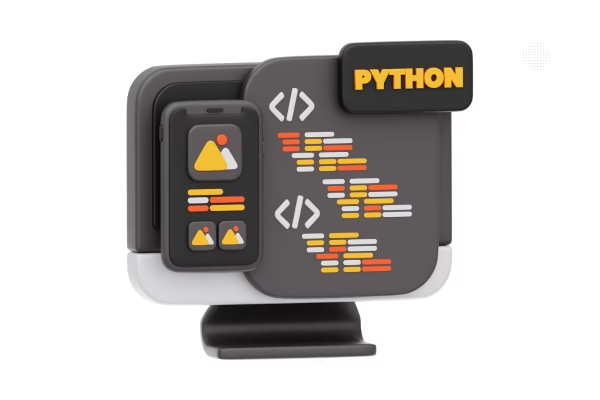From Code to Python: Gentle Guide for Programmers & Learners
Introduction
Welcome! This article series teaches Python fast from the ground up without assuming you’re a total beginner to programming. If you’ve written code in languages like C/C++, Java, JavaScript/TypeScript, Go, or Ruby, you’ll find side‑by‑side explanations that map familiar concepts to Python’s syntax and idioms.

By the end, you’ll be able to read and write clean Python, and you’ll ship a small but useful Sales Generator CLI that stores data in SQLite.
Who this is for
- Developers comfortable with basic programming concepts (variables, loops, functions) who are new to Python.
- Self‑learners who like lots of tiny exercises and a hands‑on project.
What you’ll learn
- Python’s core syntax and how it differs from other languages (indentation over braces, dynamic typing, truthiness, slicing, etc.).
- Practical use of lists, tuples, (and when we get to JSON, we’ll introduce dictionaries), plus control flow and functions.
- How to design and build a command‑line app with argument parsing, data validation, persistence with SQLite, and simple reporting.
How this guide is organized
1. Section 1 — Learning the Syntax We’ll tackle one topic at a time:
- Comments
- Variables
- Data types
- Conditional statements
- Loops
- Functions, scope, and return values
- Tuples and Lists (and when working with JSON, we’ll naturally meet Dictionaries)
- JSON basics
After each topic, you’ll get 2–4 quick exercises before moving on.
Section 2 — Project: Sales Generator CLI (SQLite)We’ll apply the syntax you learned to build a small app with features to:
- Add a sale
- View sales
- Update a sale
- Delete a sale
- Generate a sales report
- Exit the app cleanly
What you need
- Python 3.x installed (any recent 3.x is fine).
- A terminal (macOS/Linux shell, or Windows Terminal/PowerShell).
- A text editor (VS Code, Zed, Sublime, etc.).
- SQLite comes bundled with Python via the sqlite3 module, so no extra database server is required.
How you’ll run code in this guide
You can use either the REPL or script files.
Check that Python is available
python3 –version # or: python –version
Use the REPL for quick experiments
python3
>>> print(“Hello, Python!”)
Hello, Python!
>>> exit()
Run a script file
echo ‘print(“Hello from a script”)’ > hello.py
python3 hello.py
Conventions we’ll use
- Code blocks are in Python 3.
- #comments show notes inside code.
- We’ll prefer clear, beginner‑friendly examples over clever tricks.
Quick Setup Exercise (before we start)
- Do these now so you’re ready for the first syntax topic:
- Verify your Python version prints something like Python 3.10.x or higher.
- Open the REPL and print your name: print(“Hi, I am “).
- Create a playground.py file with a single line print(“Ready to learn!”) and run it.
- If that all worked, you’re set. In the next section, we’ll start with “What is Python?” to put the language in context before diving into comments and variables.
What is Python?
Python is a high‑level, interpreted programming language known for its readability and simplicity. Its design philosophy emphasizes clarity and reducing “boilerplate” code, which is why it’s often described as executable pseudocode.
A few quick points to understand:
- Created in 1991 by Guido van Rossum and now maintained by the Python Software Foundation.
- Widely used in web development, data analysis, AI/ML, scripting, and automation.
- Popular for its large ecosystem of libraries (NumPy, Pandas, Django, Flask, FastAPI, etc.).
Why programmers love Python
- Readable syntax: You don’t need curly braces {} or semicolons ;. Indentation defines code blocks.
- Dynamic typing: No need to declare types explicitly. Variables can hold different types over their lifetime.
- Cross‑platform: Runs everywhere — Windows, Linux, macOS.
- Massive community: You’ll always find tutorials, forums, and libraries.
Compare at a glance
Here’s a tiny side‑by‑side snippet of a “Hello, World” in Java vs. Python:
Java
class HelloWorld {
public static void main(String[] args) {
System.out.println(“Hello, World”);
}
}
Python
print(“Hello, World”)
That’s the essence: Python tries to remove ceremony and get straight to the logic.
Comments in Python
Comments are notes you leave in your code for yourself or other programmers. They’re ignored by Python when the program runs.
Single-line comments
Use the # symbol. Everything after it on that line is ignored.
# This is a comment
print(“Hello”) # This comment explains the line
Multi-line comments (docstrings)
Python doesn’t have true multi-line comments like /* … */ in C/Java, but you can use triple quotes (”’ or “””) as block comments or documentation strings:
“””
This is a multi-line comment or docstring.
It can describe what a function or file does.
“””
print(“Python comments demo”)
Docstrings are often used for documenting functions, classes, or modules.
Why comments matter
- They explain why you wrote code a certain way.
- They make collaboration easier.
- They serve as reminders for the future you!
Exercises — Comments
- Write a program that prints your favorite color. Add a single-line comment explaining the choice.
- Add a multi-line docstring at the top of your program describing what the program does.
- Try writing code without comments, then go back and add comments to explain tricky parts. Notice the difference.
Variables in Python
A variable is simply a name that refers to a value in memory. Unlike C, Java, or Go, you don’t declare a type when creating a variable in Python — it’s dynamically assigned.
Declaring variables
name = “Vishal” # string
age = 25 # integer
height = 5.9 # float
is_student = True # boolean
Key differences vs. other languages
- No need for type keywords like int, string, or boolean.
- Assignment uses a single equals sign =.
- Variable names follow snake_case convention (e.g., total_sales).
- Case-sensitive: Name and name are different variables.
Reassigning variables
You can change the type of value stored:
x = 10
x = “Now I’m a string”
print(x) # Output: Now I’m a string
This flexibility is powerful but requires careful handling in larger programs.
Multiple assignments
Python allows assigning multiple variables in one line:
a, b, c = 1, 2, 3
print(a, b, c) # Output: 1 2 3
Or giving the same value to multiple variables:
x = y = z = 0
print(x, y, z) # Output: 0 0 0
Exercises — Variables
- Define a variable name and assign your own name to it.
- Create three variables: city, country, and population. Assign appropriate values.
- Reassign a variable from an integer to a string. Print it before and after.
- Swap the values of two variables a and b in one line using Python’s multiple assignment.
Data Types in Python
Python provides several built-in data types. Understanding them is key to writing effective code.
Numbers
- Integers (int): Whole numbers.
- Floats (float): Numbers with decimals.
- Complex numbers (complex): Rare in everyday code.
x = 10 # int
y = 3.14 # float
z = 2 + 3j # complex
Strings
A string is text inside quotes.
message = “Hello, World!”
print(message.upper()) # HELLO, WORLD!
Python strings are powerful — they support slicing:
word = “Python”
print(word[0:3]) # Pyt
print(word[-1]) # n
Booleans
Boolean values are either True or False.
is_active = True
print(5 > 3) # True
Lists
Lists are ordered, mutable collections.
fruits = [“apple”, “banana”, “cherry”]
fruits.append(“orange”)
print(fruits) # [‘apple’, ‘banana’, ‘cherry’, ‘orange’]
Tuples
Tuples are like lists, but immutable (cannot be changed).
coordinates = (10, 20)
print(coordinates[0]) # 10
Dictionaries
Dictionaries store data as key-value pairs.
person = {“name”: “Alice”, “age”: 30}
print(person[“name”]) # Alice
Type checking
Use type() to inspect a variable’s type.
x = 42
print(type(x)) # <class ‘int’>
Exercises — Data Types
- Create a variable temperature with a float value. Print its type.
- Define a string greeting and print the first 3 characters.
- Make a list of 5 countries. Add one more country to it.
- Define a tuple with your birth year and birth month.
- Create a dictionary with keys title and author for your favorite book.
Conditional Statements in Python
Conditionals let you execute different code based on whether a condition is true or false.
If statement
x = 10
if x > 5:
print(“x is greater than 5”)
Notice: indentation matters in Python. No {} braces the block is defined by spaces.
If-else
age = 18
if age >= 18:
print(“You are an adult”)
else:
print(“You are a minor”)
Elif (else if)
score = 85
if score >= 90:
print(“Grade: A”)
elif score >= 75:
print(“Grade: B”)
elif score >= 60:
print(“Grade: C”)
else:
print(“Grade: F”)
Comparison operators
- == equal
- != not equal
- <, >, <=, >=
Logical operators
- and (both true)
- or (at least one true)
- not (negation)
x = 10
y = 20
if x > 5 and y > 15:
print(“Both conditions are true”)
Exercises
- Write a program that checks if a number is positive, negative, or zero.
- Create a variable age and print whether the person is a child (<13), teenager (13–19), or adult (20+).
- Write a program that checks if a number is divisible by both 2 and 3.
Loops in Python
Loops let you repeat code multiple times.
For Loop
Iterates over a sequence (list, tuple, string, range).
# Loop over a list
fruits = [“apple”, “banana”, “cherry”]
for fruit in fruits:
print(fruit)
# Loop over a range of numbers
for i in range(5): # 0 to 4
print(i)
While Loop
Repeats as long as a condition is true.
count = 0
while count < 5:
print(count)
count += 1
Break and Continue
- break exits the loop immediately.
- continue skips the rest of the loop and goes to the next iteration.
for i in range(5):
if i == 3:
break # exits loop
print(i)
for i in range(5):
if i == 3:
continue # skips 3
print(i)
for i in range(5): if i == 3: break # exits loop print(i)
for i in range(5): if i == 3: continue # skips 3 print(i) Exercises
1. Print numbers from 1 to 10 using a for loop.
2. Print all even numbers from 0 to 20 using a while loop.
3. Iterate over a list of 5 names and print each name.
4. Use a loop to find the first number divisible by 7 between 1 and 50 and break when found.
Functions, Scope, and Return Values
Functions let you group code into reusable blocks. Python functions are defined with def.
Defining a function
def greet(name):
print(f”Hello, {name}!”)
Calling a function
greet(“Vishal”) # Hello, Vishal!
Function arguments and return values
def add(a, b):
return a + b
result = add(5, 7)
print(result) # 12
Default arguments
def greet(name=”Guest”):
print(f”Hello, {name}!”)
greet() # Hello, Guest!
greet(“Alice”) # Hello, Alice!
Scope
- Local variables: defined inside a function, only accessible there.
- Global variables: defined outside functions, accessible anywhere.
x = 10 # global
def my_func():
y = 5 # local
print(x, y)
my_func() # 10 5
# print(y) # Error: y is not defined
Exercises
- Write a function square that returns the square of a number.
- Create a function is_even that returns True if a number is even, False otherwise.
- Write a function that takes a name and prints a greeting, with a default value for the name.
- Experiment with a local variable inside a function and try accessing it outside (observe the error).
Tuples, Lists, and JSON Basics
Tuples
Tuples are ordered, immutable collections. Once you create a tuple, you cannot change its values.
point = (10, 20)
print(point[0]) # 10
print(point[1]) # 20
- Useful for fixed collections of items.
- Can be used as keys in dictionaries because they are immutable.
Lists
Lists are ordered, mutable collections. You can add, remove, or change items.
fruits = [“apple”, “banana”, “cherry”]
fruits.append(“orange”)
print(fruits) # [‘apple’, ‘banana’, ‘cherry’, ‘orange’]
fruits[1] = “blueberry”
print(fruits) # [‘apple’, ‘blueberry’, ‘cherry’, ‘orange’]
- Lists support slicing, iteration, and various built-in methods like append(), pop(), remove().
JSON
import json
# Python dict to JSON string
data = {“name”: “Vishal”, “age”: 25}
json_str = json.dumps(data)
print(json_str) # ‘{“name”: “Vishal”, “age”: 25}’
# JSON string to Python dict
parsed = json.loads(json_str)
print(parsed[‘name’]) # Vishal
- JSON is great for saving structured data or exchanging it with APIs.
- Python’s json module handles serialization and deserialization easily.
Exercises
- Create a tuple of coordinates with values 10 and 20, and print both values.
- Create a list of colors with 3 color names, add another color using append, and then change the first color.
- Convert a Python dictionary {“product”: “book”, “price”: 200} into a JSON string and print it.
- Parse the JSON string back into a dictionary and print the value of product.
- Experiment by creating a list of dictionaries representing 3 students with keys name and score.





